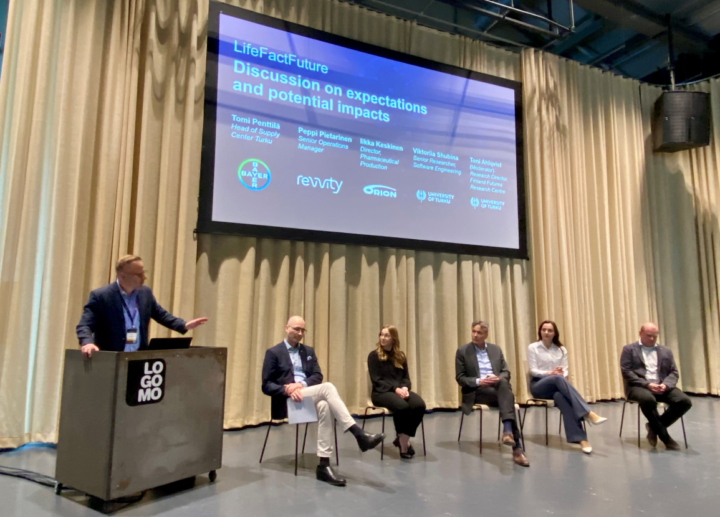First Version of the Future Life Science Factory Launched
LifeFactFuture participated yesterday 10 June in the Futures Conference 2025 organised by the Finland Futures Research Centre and VTT at Logomo in Turku. This year’s conference theme was Future of Technologies – Mutual Shaping of Socio-Technical Transformations. The event gathered over 330 participants from 40 different countries. It was an excellent forum to publish the draft of the future life science factory.
Several representatives of the consortium were present at the event. Professor Toni Ahlqvist and WP1 lead Tero Villman unveiled the draft of the future life science factory. Sara Gambier from Bayer and Mikael Lindblad from Nokia commented on the published draft and shared their companies’ motivations for participating in the consortium project.
The newly published draft outlines what a life science factory might look like in 2040. We will continue developing this draft in collaboration with the consortium. The work will also serve as a foundation for the project’s upcoming sprints, where future technologies will be practically tested in a production environment. This collaboration between technology and life science companies and research groups can lead to exciting new opportunities.
Collaboration Makes Us Better
A panel discussion followed the publication of the draft, featuring Tomi Penttilä, recently appointed CEO of Bayer Finland, Peppi Pietarinen from Revvity, Iikka Keskinen from Orion, Viktoriia Shubina from the University of Turku, and Mikael Lindblad from Nokia. The shared message was clear: “Collaboration makes us better and more competitive.”
The Industry’s Clock Speed Must Change – Safely
In her presentation, Sara Gambier summarised the message from several consortium companies on why participating in a co-innovation project is important. The operating environment and technologies are changing rapidly. The life science sector, traditionally slow-paced and heavily regulated, must ensure its competitiveness. This requires strong investment in digitalisation, as well as the development of production and expertise. Activities must be developed and optimised using data and AI, while keeping the end-user and patient safety in mind. Communication with Fimea, which provides expert input to the project, is crucial in this regard.
We Must Dare to Be Bold Enough
Finland’s life science production cannot compete globally on price. Its competitive edge must come from expertise, innovation, and the ability to combine these within a network. Ecosystem projects like LifeFactFuture enable bold experimentation and the acceleration of innovation.
The barriers to competitiveness in the life science sector are not necessarily technical. We already have many of the technologies that will be used in future factories. Significant changes must also be made in leadership, established practices, and even the language used. As Tomi Penttilä aptly said during the panel: “We must be bold enough to embrace change in the industry,” and Mikael Lindblad added: “Not embracing digitalization — that’s what’s truly expensive.”

